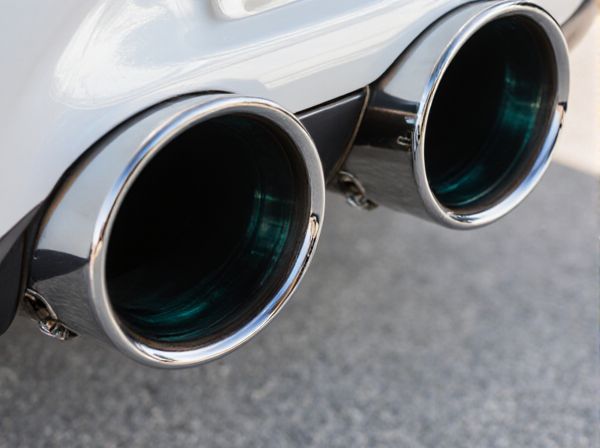
Photo illustration: Glasspack vs Chambered
Glasspack mufflers provide a straight-through design for maximum exhaust flow and louder sound, making them popular for muscle cars and hot rods. Chambered mufflers use internal chambers to redirect exhaust flow, reducing noise while maintaining some performance benefits. Your choice depends on whether you prioritize aggressive sound and flow or quieter operation and refined exhaust tone.
Table of Comparison
| Feature | Glasspack Muffler | Chambered Muffler |
|---|---|---|
| Design | Straight-through with fiberglass packing | Series of chambers for sound reflection |
| Sound | Loud, aggressive, deep tone | Moderate, throaty, tuned exhaust note |
| Performance | Minimal backpressure, improved horsepower | Moderate backpressure, balanced performance |
| Durability | Fiberglass may degrade over time | Metal construction, generally longer-lasting |
| Best Use | Muscle cars, street performance, racing | Daily driving, street cars needing sound control |
| Cost | Typically lower cost | Usually higher cost |
Introduction to Glasspack and Chambered Mufflers
Glasspack mufflers feature a straight-through design with a perforated pipe surrounded by sound-absorbing fiberglass, offering minimal backpressure and a loud, aggressive exhaust note preferred in muscle cars and hot rods. Chambered mufflers utilize internal chambers to reflect and cancel sound waves, providing a deeper, more refined tone and improved noise reduction without significantly restricting exhaust flow. Both types balance performance and sound differently, catering to specific automotive customization goals.
How Glasspack Mufflers Work
Glasspack mufflers use a straight-through design with a perforated inner tube surrounded by fiberglass packing, which absorbs sound waves and reduces exhaust noise by dissipating sound energy. This configuration allows for minimal restriction of exhaust flow, promoting increased engine performance and a deep, aggressive exhaust tone. Unlike chambered mufflers that use internal chambers to reflect and cancel sound waves, glasspacks rely primarily on sound absorption through their dense fiberglass filling.
How Chambered Mufflers Work
Chambered mufflers work by directing exhaust gases through a series of internal chambers that reflect sound waves to cancel out specific frequencies, effectively reducing noise without significantly restricting airflow. Each chamber is precisely engineered to target certain sound waves, creating destructive interference that lowers overall exhaust sound levels. This design enhances engine performance by maintaining optimal backpressure while providing a deep, throaty exhaust tone preferred in muscle cars and performance vehicles.
Sound Differences: Glasspack vs Chambered
Glasspack mufflers produce a loud, straight-through exhaust tone with minimal restriction, emphasizing high-pitched, aggressive sound ideal for muscle cars and hot rods. Chambered mufflers use internal baffles and chambers to create a deeper, smoother, and more refined exhaust note by reducing noise levels and controlling sound waves. The main sound difference is that glasspacks offer raw, throaty power, while chambered mufflers provide balanced, resonant tones with enhanced street drivability.
Performance Comparison
Glasspack mufflers offer a straight-through design that enhances exhaust flow and provides a louder, more aggressive sound, improving engine performance and horsepower. Chambered mufflers use internal chambers to reflect sound waves, reducing noise more effectively but introducing some backpressure that can slightly decrease performance. For optimal horsepower gains and minimal exhaust restriction, glasspack mufflers generally outperform chambered designs in high-performance applications.
Durability and Longevity
Chambered mufflers generally offer greater durability and longevity due to their robust internal baffle construction, which resists corrosion and wear better than glasspack mufflers. Glasspack mufflers feature a straight-through design with fiberglass packing that degrades over time, reducing effectiveness and requiring more frequent replacement. Choosing chambered mufflers enhances exhaust system lifespan and maintains sound control under harsh conditions.
Installation Process
The installation process for Glasspack mufflers is typically straightforward, requiring fewer modifications due to their simple tubular design and universal fitment, making it ideal for quick replacement or upgrades. Chambered mufflers often demand precise alignment and additional welds because of their segmented internal chambers that alter exhaust flow and noise, which can extend installation time and complexity. Both types benefit from professional installation to ensure optimal performance and prevent leaks, but Glasspacks generally offer faster and easier installation for most vehicle models.
Cost and Value Analysis
Glasspack mufflers generally offer a lower initial cost compared to chambered mufflers, making them a budget-friendly option for basic exhaust sound and performance enhancements. Chambered mufflers, while more expensive upfront, provide superior sound control and durability, delivering greater long-term value through enhanced noise reduction and improved exhaust flow. Analyzing cost versus value, chambered mufflers often justify their higher price with better overall performance and longevity, appealing to consumers seeking a balanced investment in quality and sound customization.
Best Applications for Each Type
Glasspack mufflers excel in high-performance applications where maximizing exhaust flow and producing a deep, aggressive sound are priorities, making them ideal for muscle cars, drag racing, and vintage hot rods. Chambered mufflers are best suited for street vehicles and daily drivers seeking a balanced blend of sound reduction and performance, offering a smoother and more refined exhaust note. Both muffler types optimize engine efficiency differently, with glasspacks emphasizing minimal backpressure and chambered designs focusing on noise cancellation through internal chambers.
Choosing the Right Muffler for Your Vehicle
Choosing the right muffler for your vehicle depends on your desired sound and performance goals. Glasspack mufflers provide a loud, aggressive exhaust note ideal for muscle cars and trucks seeking maximum flow and minimal restriction. Chambered mufflers offer a deeper, more refined tone with enhanced sound control, suitable for drivers prioritizing noise reduction and a smoother ride.
 caratoz.com
caratoz.com